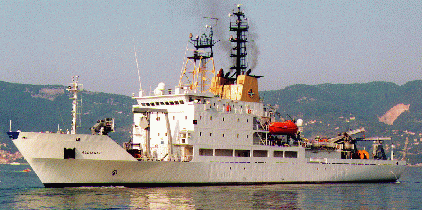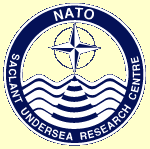
Assessment of Skill for Coastal Ocean Transients
ASCOT-02
Tyrrhenian Sea/Ligurian Sea/Elba/Procchio Bay
May 2002
An Experiment for Ocean Coastal Prediction and
NATO Rapid Environmental Assessment Skills Evaluation

NATO NRV Alliance

|
A.R. Robinson, W. G. Leslie, R. Onken |

|
Participating Institutions
Harvard University
SACLANT Undersea Research Centre
1. Introduction Coastal Predictive Skill Experimentation (CPSE) measures the ability of a
forecast system to combine model results and observations in coastal domains or
regimes and to accurately define the present state and predict the future state.
Rapid Environmental Assessment (REA) is defined in the military environment as
"the acquisition, compilation and release of tactically relevant environmental
information in a tactically relevant time frame". Ocean forecasting is
essential for effective and efficient REA operations. A REA CPSE must be
designed to determine forecast skill on the basis of minimal and covertly
attainable observations and thus may be most efficiently carried out in the
context of the definitive over-sampling provided by a CPSE. Environmental observations are a necessity for initialization and updating of
ocean forecasts. Numerical ocean forecast capabilities in general consist of
observational networks, data assimilation schemes and dynamic forecast models.
Since observations are the most expensive part of the forecast and are often
difficult to achieve, methods that would reduce the requirements are highly
desirable. Knowledge of features, structures and the dynamics which evolves
them is necessary for successful forecasting. Adaptive sampling of the
observations of greatest impact increases efficiency and can drastically reduce
the observational requirements, i.e. by one or two orders of magnitude. This
project will develop methodology for ocean forecasting using minimum input. The Assessment of Skill for Coastal Ocean Transients (ASCOT) project is a
series of real-time CPSE/REA experiments and simulations focused on quantitative
skill evaluation and cost-effective forecast system development. ASCOT-01, carried out
in Massachusetts Bay/Gulf of Maine in June 2001, was the first such
experiment. ASCOT-02 will take place in the Eastern Ligurian Sea in May 2002.
2. Goals and Objectives ASCOT Overall Goal: to enhance the efficiency, improve the accuracy and
extend the scope of nowcasting and forecasting of oceanic fields for Coastal
Predictive Skill Experimentation and for Rapid Environmental Assessment in the
coastal ocean and to quantify such CPSE and REA capabilities. ASCOT General Objectives: ASCOT-02 Objectives:
REA requires multiscale capabilities for different kinds of warfare (e.g. anti-submarine (ASW), mine warfare (MW), etc.). An experiment which is to assess the predictive skill of a forecast system must therefore measure and evaluate on multiple scales. Knowledge of the multiscale dynamics is essential. Skill metrics will be designed to take the coupling of scales into account. All coastal regions require both generic and regional-specific metrics for the dominant variabilities. For example, upwelling is a generic process, however, the location and time of occurrence of upwelling is specific to the region.
As a predictive skill experiment, ASCOT-02 will include oversampling, in order that sources of error can be tracked. During the verification survey a significant fraction of the initialization survey will be repeated. Specific goals of the adaptive sampling will include: specification of the sampling patterns for the AUVs; sampling in regions not yet covered to locate local structures; sampling in regions not recently covered to understand the evolution of structures; sampling to determine the strength and structure of the anticyclone north of Elba; sampling to determine the general nature of the flow in vicinity of Procchio Bay (e.g.. is it from the north or the result of flow through the Corsican Channel from the Tyrrhenian turning around the island?); sampling to evaluate the structure and evolution of the flow between Corsica and Elba; sampling to determine the impact of the flow between Elba and the coast of Italy; and, sampling to determine the nature of conditions in Procchio Bay; coupling of wind-response and buoyancy currents; and, reduction of multi-variate forecast errors.
| Nowcast and Forecast Products | Channel Domain |
| 10 May 2002 | X |
| 11 May 2002 | X |
| 13 May 2002 | X |
| 14 May 2002 | X |
| 17 May 2002 | X |
The real-time analyses and forecasts are being produced by the Harvard Ocean Prediction System under the guidance of Prof. Allan R. Robinson. The forecasts of physics are being carried out at Harvard University Dr. Patrick J. Haley, Jr. and Dr. Reiner Onken. Data processing, analysis and web pages are the responsibility of Wayne G. Leslie